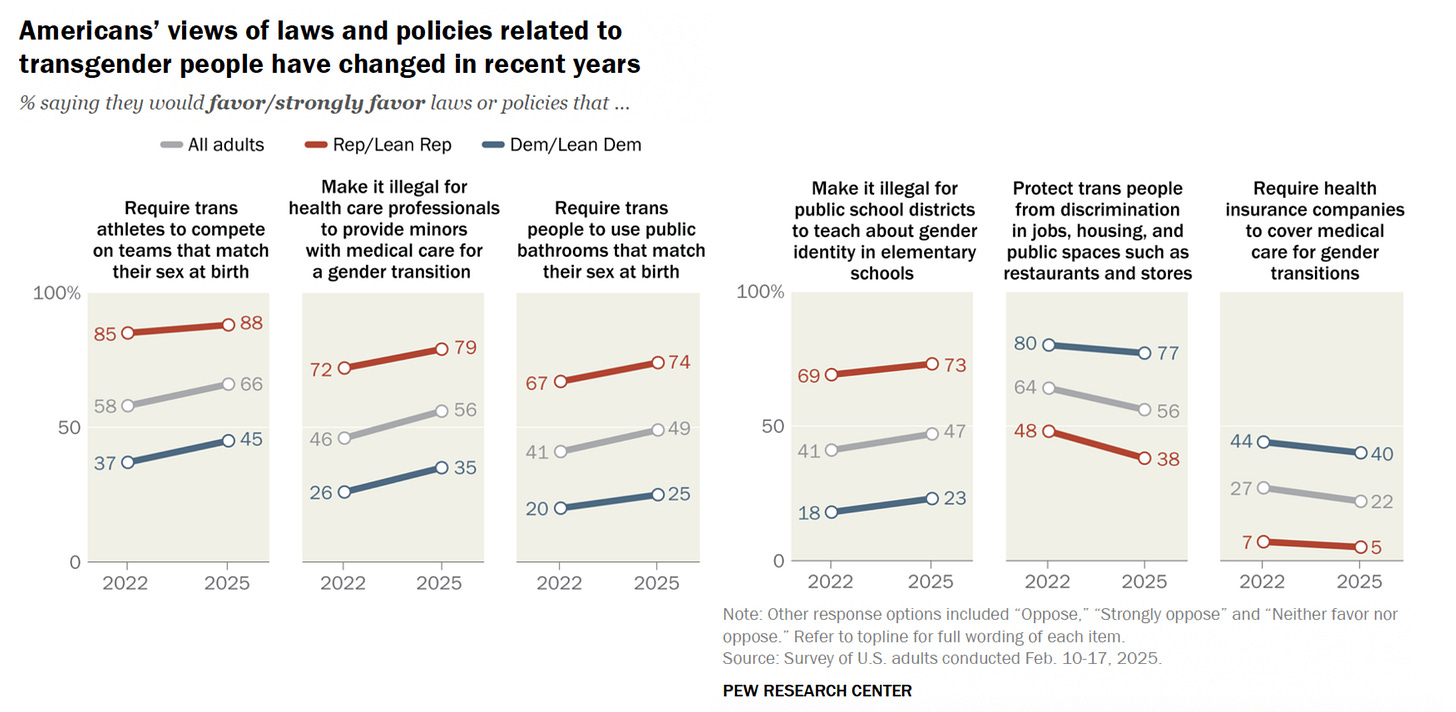Trans Activists Are Society’s Most Accomplished Transphobes
The trans movement has been a once-in-a-generation gift to the political right. And LGBT people will pay the price.
This essay is a companion to another piece published today: Anti-Trans Activists are Unprincipled and Depraved.
In the aftermath of the summer of George Floyd in 2020, a phrase heard often in progressive spaces whenever someone was being fired or pilloried for inadvertently causing offense was that “intent doesn’t matter.” It’s a sentiment still commonly heard in left-activist circles. The idea is that if one says or does something deemed to have had a negative impact on a person or group perceived as disadvantaged, it does not matter if their intentions were benign or even good. Rather, they are to be evaluated no differently from someone who intentionally set out to hurt people. To be sure, this is a deeply misguided notion. The role of intentions in forming rational moral judgments is indispensable. But if we are to accept this flawed thinking, it casts critical social justice activism in general, and trans activism in particular, in a decidedly scathing light. For if impact matters more than intent, then trans activism, by the numbers, must be considered the foremost bastion of transphobia in modern society.
Over the past 15 years, trans politics rose from obscurity to become one of the most prominent topics of discourse. During this time, trans activism exploded. At the advent of the 2010s, trans advocacy groups were a blip on the radar. Today, the nonprofit database Guidestar brings up over 12,000 results for the search term “transgender.” US-based foundations now spend nearly six times more on trans, non-binary, and gender-nonconforming causes than on lesbian, gay, and bisexual causes combined. The effect? A catastrophic, across-the-board backlash in public opinion.
Trans Activism by the Numbers
The backslide begins with the most foundational claim of trans issues: that gender is a concept distinct from biological sex, and that people can have gender identities different from their sex. In other words, the notion that it is even possible to be trans in the first place. In 2017, Pew Research found that 44 percent of US adults believed that one’s gender could be different from their sex, while 54 percent believe gender was “determined by sex at birth.” For a public largely unfamiliar with trans people or issues, these weren’t bad numbers. Five years later in 2022 — a span during which funding for trans-related nonprofits rose by over 44 percent — Pew found that only 38 percent said that one’s gender could be different from their sex. In 2025, that number had slipped further to 33 percent, and among teenagers, to 30 percent. Pew also found that a majority of Democrats (50 percent to 49) no longer believe that people can have a gender different from their sex.
The trans movement also lost significant ground on the most controversial edge cases. Between 2021 and 2025, Gallup found a 10-point drop in the percentage of people who support trans athletes competing in categories that align with their gender identity. 69 percent of Americans now say that trans athletes should only be allowed to play on teams that match their birth sex. This figure was 79 percent in a 2025 New York Times/Ipsos poll, including 64 percent among independents and 67 percent among Democrats. This same Times poll also found that 71 percent of voters — including 54 percent of Democrats — believed that “no one under 18 should have access” to puberty-blocking drugs and hormone treatments as part of transgender care. Similarly, support for trans people using the bathrooms of their choice fell precipitously. In 2016, only 32 percent of Americans favored laws requiring trans people to use the bathrooms corresponding to their sex. By 2022, this figure was 42 percent, and by 2025, 49 percent.

But the erosion in public support has gone well beyond hot-button edge cases and into far more concerning territory. 52 percent of Americans approve of the job President Trump is doing with regard to trans issues. 49 percent say that “society has gone too far in accommodating transgender people.” 49 percent want trans issues out of politics entirely. 66 percent do not believe people of any age should be allowed to legally transition via driver’s licenses or passports. And 60 percent do not believe that it is “morally acceptable” to change one’s gender. Across the pond in the UK, 51 percent of people thought that transgender women were women in 2021. By 2023, that number had dipped to 33 percent. Today, a plurality of Brits believe that people should not be able to transition legally or socially.
This backlash has also made the jump from trans issues to gay, lesbian, and bi issues. In 2022, 71 percent of US adults believed that same-sex relations were morally acceptable. In 2025, that figure is 64 percent. Support for same-sex marriage has also seen a three-point drop during this same span (from 71 to 68 percent). In 2015, 51 percent of Americans believed that gay, lesbian, and bisexual people were born that way. Today, that figure is 45 percent. There has even been a five-point decline in support for legal protections for LGBT people against discrimination in housing and employment, from 80 percent in 2022 to 75 percent in 2025. Among trans people specifically, support for discrimination protections dropped across all political sides.

Where opinions lead, policy follows. Politicians reacting against trans activists have begun waging campaigns against Pride Month and LGBT people as a whole. The political climate online has grown palpably more hostile. And opposition to all things trans has become not merely a campaign plank of the Republican Party, but a winning one. In the weeks leading up to the 2024 election, the Trump campaign ran ads showing images of trans and non-binary people alongside Kamala Harris with the tagline “Kamala is for they/them, President Trump is for you.” The ad ran 30,000 times in every swing state, and an analysis by the Harris-supporting Super PAC Future Forward found that it shifted the race 2.7 percentage points toward Trump.

Clearly, mainstream trans activism has gone terribly, terribly wrong. The hardline and uncompromising stances pushing for virtually unqualified admittance of trans women into female sports, prisons, and rape shelters are wildly out of step with public opinion. The incursions of trans activism into K-12 education and the almost libertarian aversion to regulation when it comes to puberty blockers or medical transition for kids could form the basis for a textbook on how to create a backlash. Likewise, the antics for which radical trans activists have become known — scare- and guilt-mongering, online shaming campaigns, shouting down critics, trying to get them fired, and putting them on lists1 — have been a masterclass in political self-sabotage. Women, it also turns out, don’t much enjoy being called “vulva owners”, “pregnant people”, “menstruators”, or “bodies with vaginas.” The sum total of these trends has produced the understandable impression that an extremist and authoritarian agenda is being jammed down people’s throats without their consent, and the fallout it has created is turning back the clock on social attitudes to the detriment of trans people, LGB people, sexual freedom, and individual liberty more broadly.
Trans activism has failed trans people. It has failed as spectacularly as it is possible for any activist movement to fail. It has lost the support of Democrats and teenagers on key issues. The religious right could not have achieved a more favorable result if they ran the past decade back and replaced every trans activist with a Heritage Foundation plant. Given that we are still in the early years of this rightward cultural swing, we will likely see all of the attitudes discussed here continue to deteriorate, and by the time the anti-trans wave crests and begins to recede, a generation’s worth of progress on human rights may be undone.
Most trans activists are not trans themselves. And most trans people are not activists. They are simply people, no different from you or me, who wish to live their life as they see fit, free from intimidation, harassment, discrimination, and government infringement. Trans activists succeeded in putting trans issues on the map, but far from winning any lasting victories, they have only managed to make the people on whose behalf they claim to speak an enemy in the eyes of the public. At this point, the only difference between the “pro”-trans and anti-trans movements is hair color.
See also: “Anti-Trans Activists are Unprincipled and Depraved”
Subscribe now and never miss a new post. You can also support the work on Patreon. Please consider sharing this article on your social networks, and hit the like button so more people can discover it. You can reach me at @AmericnDreaming on Twitter, @jamie-paul.bsky.social on Bluesky, or at AmericanDreaming08@Gmail.com.
I’m on one such list created by the trans activist Andrea James.






They pushed the envelope a little further; a little further and it fell over the edge. I think Progressives and Democrats in general need to look at Trans activism circa 2020-25 led to negative results for both the specific issue and the Progressive movement in general. The real cause of this problem was the absolute unacceptability of taking positions that might be considered “offensive” or “unsupportive” of any “marginalized group”. It was just like “Defund the Police”. I’m sure there was widespread cringe over that yet how many elected representatives or national pundits stood up and said: this is nonsense; nobody I’d defunding the police”. The said nothing, and by default ended up owning the issue. Progressives and centrist Democrats need to speak up when they do not agree with something and those on the “cutting edge” need to defend their own positions without “canceling”, “listing” or otherwise “quieting” the “friendly opposition”.
An excellent summary of how a well meaning movement was taken over by extremists! Reposting 😎